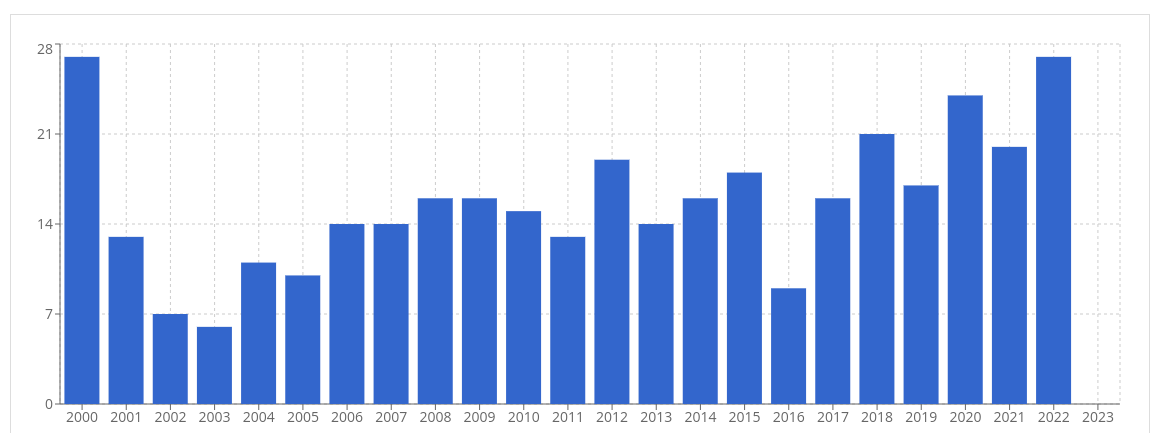Focus on Hervé Télémaque
[07 Feb 2023]Against the overall backdrop of American museums rewriting their ‘art history’, two exhibitions are currently being devoted to Hervé TELEMAQUE, a mixed-race French artist with a keen and critical mind (1937 – 2022). Disenchanted by racial oppression in the United States in the 1950s, and constantly reminded of his status as an exile, in 1961 he chose to live in Paris at a time when the French capital attracted artists from all over the world.
Subversive spirit
During the tribute paid to him in late November at the Père-Lachaise cemetery in Paris, the French historian and politician Pap Ndiaye recalled that Hervé Télémaque “lived on three continents, without having ever belonged to any”. Born in 1937 in Port-au-Prince, Télémaque remained attached to his native Haiti all his life, sometimes punctuating his paintings with scenes of everyday life in his country of origin. In New York, he immersed himself in Abstract Expressionism and in France he plunged into Surrealism alongside André Breton. However, Télémaque quickly tired of existing artistic movements, which he considered to have an unfortunate tendency to veer towards the ‘decorative’. He preferred to reflect on the social and political events of his time. It was in the early 1960s that he found his own path, becoming one of the key figures in Narrative Figuration, an important artistic movement that was ‘officially’ launched with the Parisian museum exhibition Mythologies quotidiennes in 1964.
Narrative Figuration has a close affinity with Pop Art in that they both incorporate objects and signs of consumerism and appropriate iconography from cinema, comics, cartoons or advertising. Télémaque combined various artistic approaches by associating the language of popular culture and consumption with knowingly subversive subjects. The result was works clearly designed to criticize political, economic and cultural hegemonies and that were always in dialogue with history, current events, political life, racial and colonial issues, all mixed with a fictional and autobiographical dimension.
Strong signs of recognition in the United States
Not many Contemporary French artists are honored by American institutions, but Hervé Télémaque’s work is currently the subject of two exhibitions that opened to the public at the end of 2022. The one at the Aspen museum (Herve Telemaque, A Hopscotch of the Mind, until 26 March, curated by both Hans Ulrich and Joseph Constable with Helen Marten) is in fact the first-ever exhibition of his work in an American museum and is a transferral of an earlier show in London’s Serpentine gallery curated by Hans Ulrich and Joseph Constable in 2021 . The second exhibition is being hosted by the Miami Institute of Contemporary Art (Hervé Telemaque: 1959-1964, until 30 April), with a dozen works tracing the first five years of the artist’s production. The selection of works highlights Télémaque’s relationship with American art via the paintings he made during his New York years. Having left his native Port-au-Prince in Haïti, Télémaque arrived in the American metropolis in 1957 and participated in the artistic scene dominated by Abstract Expressionism (De Kooning, Pollock, Rothko…). But, as Christian Briend, curator of a major Télémaque exhibition at the Center Pompidou in 2015, points out, he didn’t stay long on American soil because, “in New York, Hervé Télémaque was an uprooted artist facing racism.”
Hervé Télémaque: geographic distribution by number of lots sold (Copyright Artprice.com)

These two exhibitions illustrate the international interest aroused by Hervé Télémaque after a first sign in 2018 when the prestigious MoMA in New York acquired an important canvas titled The Ugly American (1962/64), a painting that refers to the failed US attempt to invade Cuba at the Bay of Pigs. The curator behind the work’s acquisition, Yasmil Raymond, was impressed by the political nature of his work and believes that the racial prejudice problems Hervé Télémaque faced in late 1950s New York are, in and of themselves, an important part of New York’s art historical narrative. Raymond herself is a good example of the recent initiatives by American museums to integrate the history of the Afro-American diasporas and to address “racial problems” which – she writes, “are still major to this day”. Her acquisition of The Ugly American was of course a tremendous boost for the artist’s visibility, and it elicited interest from a number of new American collectors.
Judging by Télémaque’s market prices at the time we can assume the MOMA paid a six-figure amount for The Ugly American. His top price at auction is above half a million dollars, a price bracket that few French artists of his generation have reached (Martial Raysse, Niki de Saint Phalle, Claude Lalanne, Daniel Buren). But, so far, none of his works have been sold in either London or New York. His auction record was generated by a 1962 diptych measuring 195 x 260 cm and titled Family portrait (Portrait de famille). The work was exhibited twice at the Center Georges Pompidou: in 1991 as part of the exhibition André Breton, Convulsive Beauty, and again in 2001 as part of the The Pop Years 1956-1968. In 2007, it reached €366,250 ($537,470) at Christie’s in Paris, but its value dipped in 2012 when it was resold via Millon & Associés (€320,000, or $426,300) to the Swiss billionaire Jean-Claude Gandur. It will certainly be included in the exhibition Pop years, shock years, 1960-1975, due to open its doors on 23 June 2023 at the Caen War Memorial.
Hervé Télémaque: number of lots at auction sold since 2000 (Copyright Artprice.com)

Télémaque’s paintings are relatively rare on the auction market: only three were dispersed during 2022, two of which were accessible for under $50,000. Five drawings changed hands for less than $5,000 each, and about twenty prints sold for under $500.
News and upcoming exhibitions:
-
Single and Multiple, until 19 February 2023. Château Lescombes – Contemporary Art Center, Eysines (Bordeaux, France)
-
Pop Years, Shock Years, 1960-1975, from 23 June 2023, at the Caen Memorial. The exhibition will include works from the collection of Swiss billionaire Jean-Claude Gandur.




 30.6
30.6
